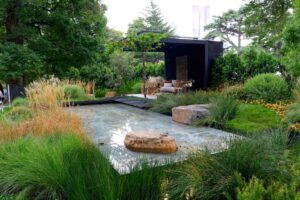
Early planning planted the seeds of ǝ’skāp’s MIFGS win, part one
By Gabrielle Stannus
Designed by Rob Cooper from Distinctive Gardens in Adelaide and constructed by Yergan Landscape and Desert Flower Landscaping, show garden ‘ǝ’skāp’ took out the City of Melbourne Award of Excellence for Best in Show, as well as a Gold medal, at the recent Melbourne International Flower and Garden Show (MIFGS). It also won the Horticultural Media Association Award for Best Use of Plant Life. I spoke with Carl Heyne from Heyne’s Wholesale Nursery in South Australia about his partnership in this award-winning garden.
Timing the growing and delivery of the approximately 1,500 plants required for ‘ǝ’skāp’ so that they were at their peak on judging day and throughout the show is no mean feat, any day of the week. Bringing those plants all the way from Adelaide to Melbourne, with one or two exceptions, took next level planning and skill as Carl Heyne, Director and General Manager of Heyne’s Wholesale Nursery found out.
‘When Rob Cooper rang me as he was driving home from MIFGS last year, asking if I wanted to be involved in 2025, I quickly said “we are in”,’ explains Carl, ‘We are a very proud South Australian family-owned business. We fly the state banner wherever and however we can. I have always recognised that Melbourne is the Rome of our industry, if we continue with that as an analogy, we consider ourselves gladiators. If Melbourne is the Rome of our industry, then MIFGS is like the Colosseum and which gladiator doesn’t want to ‘fight’ in this arena? Winning the Best in Show and Best Plantlife awards was especially sweet as I was able to celebrate it with my sister Sarah in Melbourne, who was able to take some time off from her role as Operations Manager during a very busy period in the nursery. It has been a tough year for us, having lost our father Garry to dementia about this time last year.’
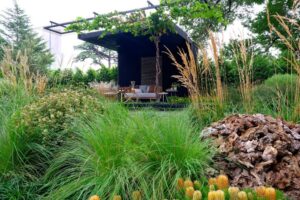
Within four to six weeks of Rob making that initial call, Carl had already started putting plants on the ground. That early action was key to their success, says Carl, combined with clear and open communication with Rob and the landscape team: ‘Often, we only get drawn into the conversation right towards the end, and then it is only really what is on the ground at the time that is available. I really tip my hat to Rob for that because his vision was to make sure that we had the best plants that we could possibly have for the project. We met regularly on site, as I wanted to make sure that we continued to meet the brief. There were a lot of the same or similar species on display in the other Show Gardens. The absolute difference was that additional length of time that went into it. These plants were purpose grown for the project with lots of lead time and communication with Rob as the designer. I do not know that growers would ordinarily have this much hands-on experience in a Show Garden. I am really blessed and lucky that Rob included me in such an early stage of it.’
One of Rob’s earliest requests of Carl was that he help to fully integrate a glory vine (Vitis vinifera) with a pergola, a feature that he had not seen delivered in a MIFGS Show Garden before. Carl’s team grew this ornamental grape vine on from stock supplied by Rob that he sourced from Red Stem Nursery. The vine and the pergola never ‘met’ each other until they were on site in Melbourne. ‘We were really privileged to be able to take this beautiful vine that had been grown and matured at Red Stem Nursery. We had it for about nine or ten months here on site at Heyne’s where we were able to then do that final sculpting and the final fit out for the pergola. It was a real privilege to take this high-quality product from Jason at Red Stem and add additional value to that.’
Carl told me that there was a lot of extra work in the background to make sure that they could pick and choose their crops as they got closer to the show: ‘We grew reserve crops as well. Some of what went into the garden was our B crop. We had these beautiful acmenas for the backdrop which ended up needing to be substituted out at the very last minute, with syzygiums going in. The acmenas had been subject to a small spike in salinity with our incoming water, which for the most part is not a big deal. However, that event coincided with a heat wave, which took the edge off the new growth. We could not in good conscience send it. We were lucky that we had a B crop and were able to send that.’
Nearing delivery day, Rob wanted more representation of the beautiful big seed heads that were on the miscanthus. ‘We had grown some, but we knew that we needed to get more because of the big impact that it had,’ says Carl, ‘So, Rob sourced some more from Red Stem Nursery, and they were genuine heroes inside that garden.’
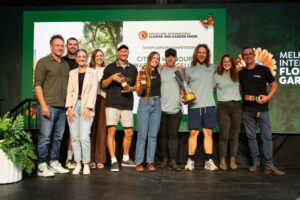
Carl also ended up sourcing ‘ǝ’skāp’s’ groundcover banksias from Victoria: ‘We had a crop in the ground and, as painful as it is to say, I could not quite hit the nail on the head with the quality of those flowers. They just weren’t good enough. I remember saying to Rob, having to swallow a little bit of pride, “I am not too proud to be prepared to jeopardise the success of this project and the judging. If you want ‘Birthday Candles’ in this project, then I am going to need to find them for you”. The other thing that we do in the background is not just grow plants, we source them as well. I reached out to Dave Matthews at Proteaflora. He has a history in South Australia as well, so that was a nice touch being able to incorporate his plants with ours.
‘Overall, the biggest source of stress and anxiety that I had was trying to walk that tight rope of the plants being too old when show time arrived. We had to upsize our product into larger size containers a couple of times just to make sure that it was healthy. Every time I did that, I had to recalculate weights and heights to make sure that we could deliver it. I am used to hitting moving targets because commercial landscaping jobs often have changing delivery dates. MIFGS was a hard-set target that was not going to move, which is a complete opposite to what we normally have, and the season was still moving.
‘The transport of the plants also needed to be continually reviewed. The old saying goes, “measure twice, cut once”. Understanding all the weights and the heights of our product was imperative. We basically had to play a giant game of Tetris fitting the plants into the vehicles We definitely measured twice and cut once, and yet when the trucks turned up, they weren’t the same height as what we had been growing to. We had to spend many hours of extra work while the truck was here trying to get the grape vine arbour to fit. Not being a horticultural truck, there was no insulation in the roof. We had to come up with a solution quickly or our plants were not going to survive the 38°C forecast for the way over to Melbourne through Bordertown during the daytime. All the Syzygium ‘Backyard Bliss,’ were touching the roof as well. We had to very purposefully cut and slide some carboard boxes into the channels in the roof. We had additional support from Plant Access too, particularly Jackie and Maria; they helped to bring another load of plants over to Melbourne. I drove one of our own Heyne’s trucks ‘Stanley’ over too. The plants all arrived in good order, which I am glad to say!’
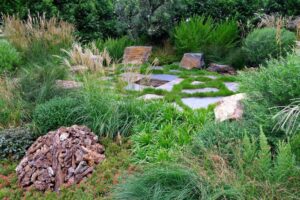
‘ǝ’skāp’ was a stunning garden, filled mostly with native plants. ‘We tried to make a lush green textured garden to challenge the perception of what native gardens look like,’ said designer Rob Cooper, ‘My design style is not this style all the times, but the shape and the form are. I really wanted to focus on trying to have a place of calm in a garden which could apply in a residential application, in a modern style house. I was trying to push the boundaries of what I can do whilst also showing other people what can be done with native plants.’
Coastal banksia (Banksia integrifolia) and the Queensland bottle tree (Brachychiton rupestris) provide height in this garden. Tussock grasses and other tussock-like plants soften this garden, adding gentle movement and a naturalistic texture to anchor the planting scheme. These plants include knobby club-rush (Ficinia nodosa), sea rush (Juncus kraussii), common tussock grass (Poa labillardierei), and kangaroo grass (Themeda triandra). Banksia ‘Birthday Candles’ provide colour at the ground level, whilst topiarised white correa (Correa alba) and grevillea spheres add shape, which Rob describes as “a different take on sculptural plants in the garden”. Dianella ‘Breeze’ and Liriope muscari ‘Emerald Cascade’ soften the walkways added an extra element of green at this level, with native violets (Viola hederacea) poking their heads through.
The sharp-eyed among you may notice in the accompanying images that a few exotic species grace this garden, including the glory vine on the pergola, the aptly named ‘no mow grass’ (Zoysia tenuifolia) covering the ground, the Chinese silver grass (Miscanthus sinensis varieties including ‘Yakushima Dwarf’) and reed grass varieties (Calamagrostis brachyandrum, C. x acutiflora ‘Karl Foerster’) blowing in the wind. Who said natives and exotics can’t be together in a garden?
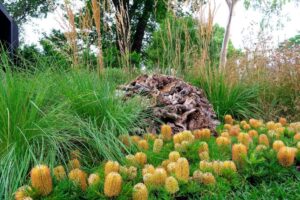
Overall, ‘ǝ’skāp’ was a beautiful garden that thoroughly deserved the awards bestowed upon it, especially the Best Use of Plantlife – the hard work of Carl and his team at Heyne’s Wholesale Nursery really paid off. This success did not happen overnight, however.
‘I often lament that growers like us spends all their time down the procurement end of the supply chain when we can add a lot more value by being at the specifications’ end of the supply chain,’ says Carl, ‘With genuine collaboration and the right lead time for the project, we can add a lot more value than just the plants that are delivered at the end.’
So, let the lesson be learnt, if you want to design and construct any type of garden for 2026 MIFGS, get on to your growers now!
Do you love your plants but weren’t able to make it to this year’s Melbourne International Flower and Garden Show? Don’t worry, I have put together some of my highlights just for you! Join me on a personal photographic tour through the gardens and plant that made the Show bloom.
Gabrielle Stannus
Inwardout Studio
M: 0400 431 277
E: gabrielle@inwardoutstudio.com
